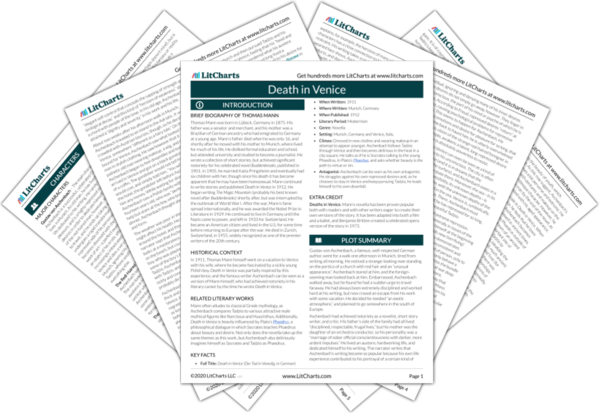Art and the Artist
One often thinks of a writer’s life and work as two very different, separate things. Death in Venice, however, shows that there is a close connection between an artist’s lived experience and work. As the narrator explains, for example, the heroism of many of Aschenbach’s characters has a close connection to his own disciplined self-restraint. His writing takes a real toll on his own body, as his wearied face shows. Aschenbach’s readers only see…
read analysis of Art and the ArtistRepression, the Mind, and the Self
At the time Thomas Mann was writing Death in Venice, Sigmund Freud had recently published some of his seminal writings on the unconscious. Mann was a reader of Freud, and was highly influenced by some of his ideas. While his story is not simply a disguised demonstration of Freud’s theories, Freudian ideas play a significant role in the novella: in particular, the idea of the unconscious, and the concept of repression. Aschenbach is a…
read analysis of Repression, the Mind, and the SelfBeauty
Mann’s novella is entitled Death in Venice for obvious reasons, but it is as much about love and desire as about death. Aschenbach wastes away while becoming increasingly obsessed with his desire for Tadzio, whom he sees as the very personification of beauty itself, and most of the work follows Aschenbach’s obsession with his beauty. The importance of beauty in the novella is often shown through its focus on Aschenbach’s voyeuristic gaze. It is…
read analysis of Beauty
Youth, Age, and Time
Aschenbach is an old man, and part of why he decides to go to Venice when he does is because he feels his time is running out. He misses his youth, and this is part of why he becomes so obsessed with Tadzio. Youth is associated with beauty in Mann’s novella, and as an artist, Aschenbach adores the beauty of youth, which inevitability fades with age. As this may suggest, Aschenbach’s obsession with youth…
read analysis of Youth, Age, and TimeTravel, Geography, and Climate
In terms of plot, Death in Venice is primarily a story of travel. Aschenbach’s journey to Venice can be seen as operating on multiple levels. Not only does he physically, literally travel to Italy, but he also travels symbolically to the realm of his unconscious and temporally to ancient Greece through his visions and dreams. Venice is continually described as a hazy, dreamlike city, part fantasy and part reality, heightening the sense of Aschenbach’s travel…
read analysis of Travel, Geography, and Climate











